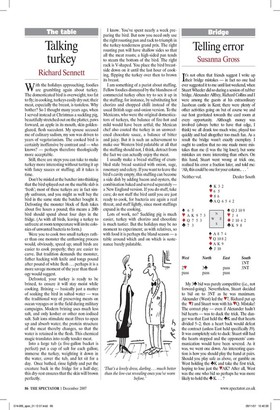Talking turkey
Richard Sennett with the holidays approaching, foodies are grumbling again about turkey. The domesticated bird is overweight, too fat to fly; in cooking, turkeys easily dry out; their meat, especially the breast, is tasteless. Why bother? So I thought many years ago, when I served instead at Christmas a suckling pig, beautifully stretched out on the platter, paws forward, an apple in its mouth, skin goldenglazed, flesh succulent. My spouse accused me of culinary sadism, my son was driven to years of vegetarianism. The cooked bird is certainly inoffensive by contrast and — who knows? — perhaps therefore theologically more acceptable.
Still, there are steps you can take to make turkey more interesting without tarting it up with fancy sauces or stuffing; all it takes is time.
Don't be misled at the butcher into thinking that the bird splayed out on the marble slab is `fresh'; most of these turkeys are in fact simply unfrozen, and you might as well buy the bird in the same state the butcher bought it. Defrosting the monster block of flesh takes about five hours a pound; this means a 201b bird should spend about four days in the fridge. (As with all birds, leaving a turkey to unfreeze at room temperature will invite colonies of unwanted bacteria to form.) Were you to cook two small turkeys rather than one monster the unthawing process would, obviously, speed up; small birds are easier to cook properly; they are easier to carve. But tradition demands the monster, father hacking with knife and tongs pound after pound of white flesh ... perhaps it is a more savage moment of the year than theology would suggest.
Defrosted, your turkey is ready to be brined, to ensure it will stay moist while cooking. Brining — basically just a matter of soaking the bird in salted water — was the traditional way of preserving meats on ocean voyages or in the field during military campaigns. Modern brining uses much less salt, and only kosher or other non-iodised salt. Salt ions stimulate meat fibres to open up and absorb water; the protein structure of the meat thereby changes, so that the water is retained in the flesh. This chemical magic translates into really tender meat.
Into a large tub (a five-gallon bucket is perfect) put a cup of salt for each gallon; immerse the turkey, weighting it down in the water, cover the tub, and let sit for a day. Once bathed, rinse lightly and put the creature back in the fridge for a half-day; this dry-rest ensures that the skin will brown perfectly.
I know. You've spent nearly a week preparing the bird. But now you need only use the right roasting pan and rack to triumph in the turkey-tenderness grand prix. The right roasting pan will have shallow sides so that all the meat roasts; a high-sided pan tends to steam the bottom of the bird. The right rack is V-shaped. You place the bird breastside down on it until the last hour of cooking, flipping the turkey over then to brown its breast.
I am something of a purist about stuffing. Fellow foodies dismayed by the blandness of commercial turkey often try to sex it up in the stuffing; for instance, by substituting hot chorizo and chopped chilli instead of the usual British sage-and-onion version. To the Mexicans, who were the original domesticators of turkeys, the balance of fire-hot and mild would have been artful; the Mexican chef also coated the turkey in an unsweetened chocolate sauce, a balance of bitter and juicy. But it is such an achievement to make our Western bird palatable at all that the stuffing should not, I think, detract from the fact we can actually enjoy the meat.
I usually make a bread stuffing of crumbled stale bread sautéed with onion, sage, rosemary and celery. If you want to leave the bird's cavity empty, this stuffing can become a side dish by adding bacon and oysters, the combination baked and served separately — a New England version. If you do stuff, take care; do not stuff the bird until you are just ready to cook, for bacteria are again a real threat, and stuff lightly, since most stuffings expand in the cooking.
Lots of work, no? Suckling pig is much easier, turkey with chorizo and chocolate is much tastier. But the holidays may be no moment to experiment; as with relatives, so with food it is perhaps the bland season — a table around which and on which is sustenance barely palatable.





































































 Previous page
Previous page